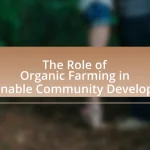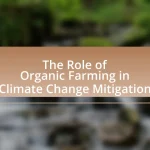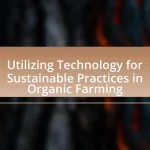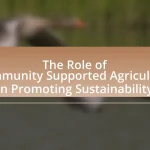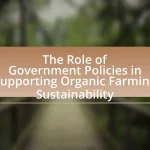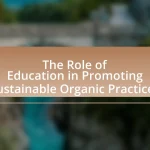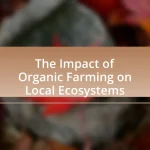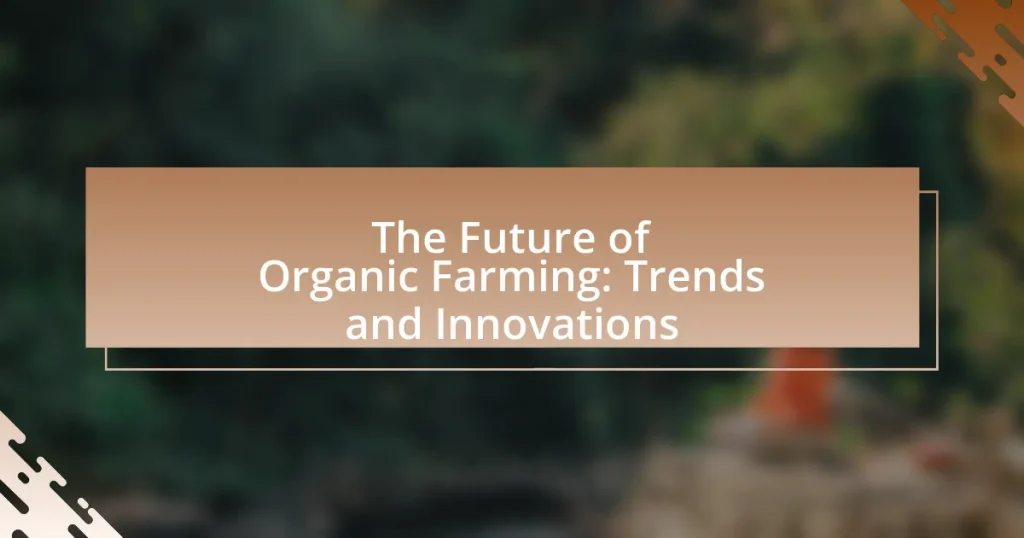The article focuses on the future of organic farming, highlighting key trends and innovations that are shaping the industry. It discusses the significant increase in consumer demand for organic products, advancements in technology such as precision agriculture, and the emphasis on sustainability through practices like regenerative agriculture. Additionally, the article examines how demographic shifts and consumer preferences are influencing farming practices, the role of technology in enhancing efficiency, and the environmental challenges posed by climate change. It also addresses the economic challenges organic farmers face, including regulatory changes and market fluctuations, while outlining best practices for future-proofing organic operations.

What are the key trends shaping the future of organic farming?
Key trends shaping the future of organic farming include increased consumer demand for organic products, advancements in technology, and a focus on sustainability. Consumer demand for organic food has grown significantly, with the global organic food market projected to reach $620 billion by 2026, according to a report by Research and Markets. Technological advancements, such as precision agriculture and data analytics, are enhancing crop yields and resource management. Additionally, sustainable practices, including regenerative agriculture and agroecology, are gaining traction as farmers seek to improve soil health and biodiversity, aligning with environmental goals. These trends collectively indicate a transformative shift towards more efficient, sustainable, and consumer-driven organic farming practices.
How is consumer demand influencing organic farming practices?
Consumer demand is significantly influencing organic farming practices by driving farmers to adopt more sustainable and environmentally friendly methods. As consumers increasingly prioritize health, sustainability, and ethical sourcing, organic farmers are responding by enhancing their practices to meet these expectations. For instance, a 2021 report from the Organic Trade Association indicated that organic food sales in the U.S. reached $61.9 billion, reflecting a growing consumer preference for organic products. This surge in demand compels farmers to implement organic certification processes, diversify crop production, and invest in eco-friendly pest management strategies, thereby aligning their operations with consumer values and market trends.
What specific consumer preferences are driving changes in organic farming?
Consumer preferences driving changes in organic farming include a growing demand for health-conscious products, environmental sustainability, and transparency in food sourcing. Health-conscious consumers increasingly prefer organic products due to perceived benefits such as reduced pesticide exposure and higher nutritional value, with a 2021 survey indicating that 76% of consumers believe organic food is healthier. Additionally, environmentally aware consumers favor organic farming practices that promote biodiversity and reduce carbon footprints, as evidenced by a 2020 report from the Organic Trade Association showing a 25% increase in organic sales linked to sustainability concerns. Lastly, the demand for transparency has led consumers to seek information about the origins and production methods of their food, prompting organic farmers to adopt traceability measures, which 60% of consumers consider important when making purchasing decisions.
How do demographic shifts impact the organic farming market?
Demographic shifts significantly impact the organic farming market by altering consumer preferences and purchasing behaviors. As populations become more health-conscious and environmentally aware, the demand for organic products increases. For instance, a report by the Organic Trade Association indicates that organic food sales in the U.S. reached $62 billion in 2020, reflecting a growing trend among younger consumers who prioritize sustainability and health. Additionally, urbanization leads to a higher concentration of consumers who are willing to pay a premium for organic products, further driving market growth. This shift in demographics, particularly among millennials and Gen Z, emphasizes the importance of organic farming in meeting the evolving needs of consumers.
What role does technology play in the evolution of organic farming?
Technology plays a crucial role in the evolution of organic farming by enhancing efficiency, improving crop yields, and facilitating sustainable practices. Innovations such as precision agriculture, which utilizes GPS and data analytics, allow farmers to optimize resource use, reduce waste, and monitor soil health more effectively. For instance, the use of drones for crop monitoring can identify pest infestations and nutrient deficiencies early, enabling timely interventions that align with organic standards. Additionally, advancements in biotechnology, such as the development of organic-approved biopesticides and biofertilizers, support pest management and soil fertility without synthetic chemicals. These technological advancements not only increase productivity but also contribute to the overall sustainability of organic farming practices.
How are precision agriculture techniques being applied in organic farming?
Precision agriculture techniques are being applied in organic farming through the use of technology to optimize crop management and resource use. These techniques include soil sensors, GPS-guided equipment, and data analytics, which help organic farmers monitor soil health, moisture levels, and crop conditions in real-time. For instance, soil sensors can provide precise data on nutrient levels, allowing farmers to apply organic fertilizers more effectively, thus enhancing crop yield while adhering to organic standards. Additionally, GPS technology enables targeted planting and harvesting, reducing waste and improving efficiency. Studies have shown that integrating precision agriculture in organic farming can lead to increased productivity and sustainability, demonstrating its effectiveness in enhancing organic farming practices.
What innovations in biotechnology are benefiting organic farmers?
Innovations in biotechnology that benefit organic farmers include the development of biopesticides, biofertilizers, and genetically engineered crops that are compatible with organic standards. Biopesticides, derived from natural materials, help control pests without harming beneficial organisms, thus promoting sustainable farming practices. Biofertilizers enhance soil fertility and plant growth by utilizing natural processes, reducing the need for synthetic fertilizers. Additionally, advancements in genetic engineering have led to the creation of crops that are resistant to diseases and pests, which can be cultivated under organic farming guidelines. These innovations contribute to increased yields, reduced chemical usage, and improved environmental sustainability, aligning with the principles of organic agriculture.
What environmental factors are affecting the future of organic farming?
Climate change significantly affects the future of organic farming by altering weather patterns, impacting crop yields, and increasing pest and disease pressures. Rising temperatures and unpredictable rainfall can lead to reduced soil moisture and increased drought conditions, which are detrimental to organic crops that rely on natural growing conditions. Additionally, the increased frequency of extreme weather events, such as floods and storms, can damage organic farms and disrupt supply chains. According to a study published in the journal “Agricultural Systems,” climate change could reduce global agricultural productivity by up to 30% by 2050, particularly affecting organic farming systems that are more sensitive to environmental changes.
How does climate change impact organic farming practices?
Climate change significantly impacts organic farming practices by altering weather patterns, affecting crop yields, and increasing pest and disease pressures. For instance, rising temperatures can lead to heat stress in crops, while unpredictable rainfall can cause both droughts and flooding, disrupting planting and harvesting schedules. Research indicates that organic farms, which often rely on biodiversity and soil health, may struggle to adapt to these rapid changes, as they are typically less reliant on synthetic inputs that can mitigate some climate effects. A study published in “Agricultural Systems” by authors Smith et al. (2021) highlights that organic farmers may face a 20-30% reduction in yields due to climate variability, emphasizing the urgent need for adaptive strategies in organic farming to sustain productivity amidst climate challenges.
What sustainable practices are being adopted to combat environmental challenges?
Sustainable practices being adopted to combat environmental challenges include organic farming techniques, agroforestry, and regenerative agriculture. Organic farming reduces chemical inputs, promoting biodiversity and soil health, which is supported by the fact that organic farms can have up to 30% higher biodiversity than conventional farms. Agroforestry integrates trees and shrubs into agricultural landscapes, enhancing carbon sequestration and improving ecosystem resilience, as evidenced by studies showing that agroforestry can sequester up to 50% more carbon than traditional farming. Regenerative agriculture focuses on restoring soil health through practices like cover cropping and no-till farming, which can increase soil organic matter by 1% annually, significantly improving soil fertility and water retention. These practices collectively contribute to mitigating climate change and enhancing food security.

What innovations are emerging in organic farming methods?
Innovations emerging in organic farming methods include the use of precision agriculture technologies, such as drones and soil sensors, which enhance crop monitoring and resource management. These technologies allow farmers to optimize inputs like water and nutrients, thereby improving yields while maintaining organic standards. Additionally, advancements in biopesticides and biofertilizers are gaining traction, providing effective alternatives to synthetic chemicals and promoting soil health. Research indicates that the global biopesticide market is projected to reach $6.4 billion by 2025, reflecting a growing trend towards sustainable pest management in organic farming. Furthermore, regenerative agriculture practices, which focus on restoring soil health and biodiversity, are being integrated into organic farming, demonstrating a holistic approach to sustainability.
How are regenerative agriculture practices transforming organic farming?
Regenerative agriculture practices are transforming organic farming by enhancing soil health, increasing biodiversity, and improving ecosystem resilience. These practices, such as cover cropping, crop rotation, and agroforestry, focus on restoring and maintaining the natural resources that organic farming relies on. For instance, a study published in the journal “Agriculture, Ecosystems & Environment” found that regenerative practices can increase soil organic matter by up to 30%, leading to improved water retention and nutrient availability. This transformation not only boosts crop yields but also contributes to carbon sequestration, making organic farming more sustainable in the long term.
What are the principles of regenerative agriculture?
The principles of regenerative agriculture include enhancing soil health, promoting biodiversity, integrating livestock, and minimizing soil disturbance. These principles aim to restore ecosystems and improve agricultural resilience. For instance, enhancing soil health through practices like cover cropping and composting increases organic matter, which can improve soil structure and water retention. Promoting biodiversity involves planting diverse crops and maintaining natural habitats, which supports beneficial organisms and pest control. Integrating livestock into crop systems can enhance nutrient cycling and reduce reliance on synthetic fertilizers. Minimizing soil disturbance through no-till farming preserves soil structure and microbial communities, leading to healthier ecosystems. These principles collectively contribute to sustainable farming practices that can mitigate climate change and improve food security.
How do these practices enhance soil health and biodiversity?
Organic farming practices enhance soil health and biodiversity by promoting natural processes that improve soil structure, fertility, and microbial activity. Techniques such as crop rotation, cover cropping, and reduced tillage increase organic matter in the soil, which enhances nutrient availability and water retention. Research indicates that organic farming can increase soil organic carbon levels by 30% compared to conventional methods, leading to healthier soils. Additionally, these practices create diverse habitats that support a wide range of organisms, from beneficial insects to soil microbes, thereby fostering a balanced ecosystem. Studies show that organic farms typically host 30% more species than conventional farms, highlighting the positive impact on biodiversity.
What advancements in pest management are being utilized in organic farming?
Advancements in pest management utilized in organic farming include integrated pest management (IPM), biopesticides, and the use of beneficial insects. IPM combines biological, cultural, and mechanical practices to control pests while minimizing chemical use. Biopesticides, derived from natural materials, offer targeted pest control with reduced environmental impact. The introduction of beneficial insects, such as ladybugs and parasitic wasps, helps maintain pest populations at manageable levels. These methods are supported by research indicating that organic farming can effectively reduce pest damage while promoting biodiversity and sustainability.
How do integrated pest management strategies benefit organic farmers?
Integrated pest management (IPM) strategies benefit organic farmers by enhancing crop yields while minimizing pest damage through a combination of biological, cultural, and mechanical control methods. These strategies reduce reliance on synthetic pesticides, which aligns with organic farming principles and promotes environmental sustainability. For instance, studies have shown that IPM can lead to a 20-30% increase in crop yields by effectively managing pest populations without harming beneficial insects. Additionally, IPM practices, such as crop rotation and the use of pest-resistant plant varieties, contribute to soil health and biodiversity, further supporting the long-term viability of organic farming systems.
What natural pest control methods are gaining popularity?
Natural pest control methods gaining popularity include the use of beneficial insects, such as ladybugs and lacewings, which prey on harmful pests. Additionally, the application of neem oil, derived from the seeds of the neem tree, is increasingly favored for its effectiveness against a wide range of insects while being safe for beneficial species. Research indicates that these methods not only reduce reliance on synthetic pesticides but also promote biodiversity in agricultural ecosystems. Furthermore, the practice of companion planting, where certain plants are grown together to deter pests, is gaining traction among organic farmers, enhancing crop resilience and yield.
How is the use of cover crops evolving in organic farming?
The use of cover crops in organic farming is evolving towards increased adoption and diversification to enhance soil health and biodiversity. Farmers are increasingly recognizing the benefits of cover crops, such as improved soil structure, reduced erosion, and enhanced nutrient cycling. According to a study published in the journal “Agronomy,” cover crops can increase soil organic matter by 0.1 to 0.3% per year, which significantly contributes to soil fertility and carbon sequestration. Additionally, innovations in seed technology and crop management practices are facilitating the integration of cover crops into various cropping systems, making them more accessible and effective for organic farmers.
What benefits do cover crops provide to organic farmers?
Cover crops provide multiple benefits to organic farmers, including improved soil health, enhanced nutrient cycling, and reduced erosion. These crops, such as clover and rye, contribute organic matter to the soil, which increases microbial activity and improves soil structure. Research indicates that cover crops can enhance nitrogen availability, with studies showing that legumes can fix up to 200 pounds of nitrogen per acre annually. Additionally, cover crops help prevent soil erosion by stabilizing the soil with their root systems, which is crucial for maintaining land productivity.
How can farmers effectively implement cover cropping strategies?
Farmers can effectively implement cover cropping strategies by selecting appropriate cover crop species that enhance soil health, suppress weeds, and improve nutrient cycling. For instance, legumes like clover and vetch fix nitrogen in the soil, while grasses such as rye and oats provide biomass that protects against erosion. Research indicates that cover crops can increase soil organic matter by 0.1 to 0.2% annually, leading to improved soil structure and fertility. Additionally, farmers should integrate cover crops into their crop rotation plans, ensuring they are planted at the right time and terminated properly to maximize benefits. This approach not only enhances crop yields but also contributes to sustainable farming practices.
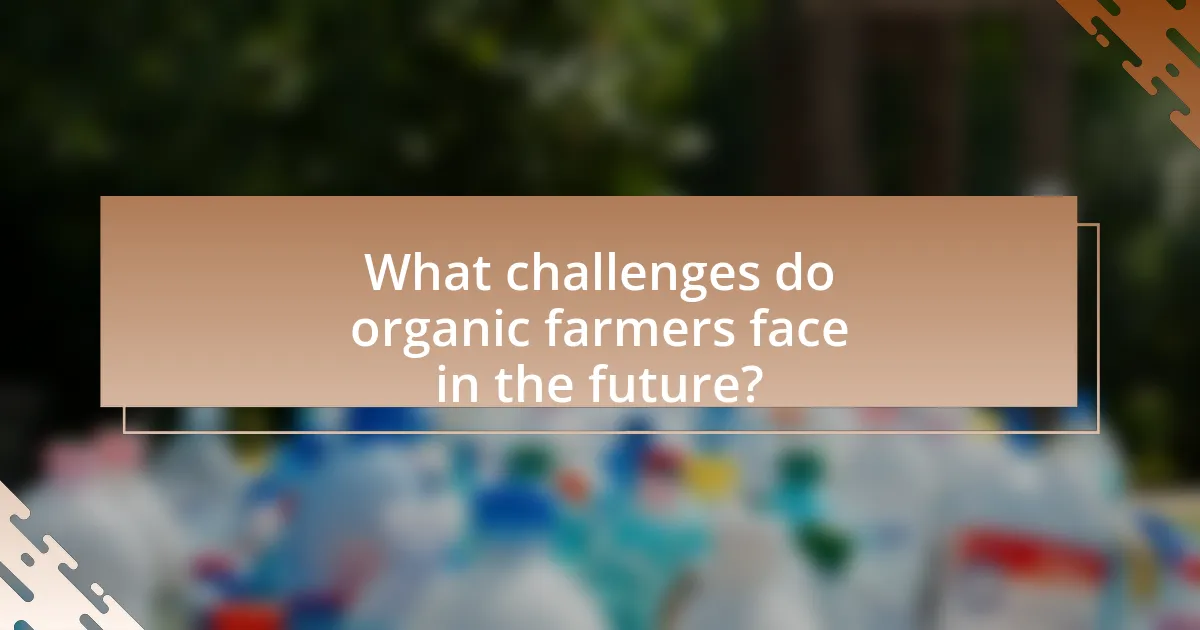
What challenges do organic farmers face in the future?
Organic farmers will face several significant challenges in the future, including climate change, pest management, and market competition. Climate change is expected to alter growing conditions, leading to unpredictable weather patterns that can affect crop yields. For instance, increased temperatures and altered precipitation can stress organic crops, making them more susceptible to diseases and pests. Pest management will become increasingly complex as new pests emerge and existing ones adapt to organic farming practices, necessitating innovative and sustainable solutions. Additionally, organic farmers will encounter heightened competition from conventional agriculture and other organic producers, which may pressure prices and market access. According to the USDA, the organic market has grown significantly, but this growth also attracts more entrants, intensifying competition. These challenges require organic farmers to adapt and innovate continuously to maintain their viability and sustainability in the agricultural landscape.
How do regulatory changes impact organic farming practices?
Regulatory changes significantly impact organic farming practices by altering compliance requirements, production standards, and market access. For instance, the introduction of stricter certification processes can increase operational costs for farmers, as they must invest in documentation and verification to meet new standards. Additionally, changes in regulations regarding pesticide use or genetically modified organisms can dictate the types of inputs that organic farmers can utilize, thereby influencing their cultivation methods. A study by the USDA found that regulatory shifts can lead to a 20% increase in compliance costs for organic producers, which may affect their profitability and sustainability.
What are the current regulations affecting organic certification?
Current regulations affecting organic certification include the USDA National Organic Program (NOP) standards, which require that organic products be produced without synthetic fertilizers, pesticides, and genetically modified organisms. These regulations also mandate that organic farms undergo annual inspections and maintain detailed records of their farming practices. Additionally, the European Union has its own set of regulations under the EU Organic Regulation, which emphasizes similar principles but includes specific labeling requirements and traceability measures. These regulations are enforced to ensure the integrity of organic products and protect consumer trust in organic labeling.
How can farmers navigate the complexities of organic regulations?
Farmers can navigate the complexities of organic regulations by thoroughly understanding the National Organic Program (NOP) standards and maintaining meticulous records of their farming practices. Familiarity with the NOP guidelines, which outline the requirements for organic certification, is essential for compliance. Additionally, farmers should engage with local certifying agents who can provide guidance tailored to specific operations. According to the USDA, over 80% of certified organic farms report that working closely with their certifiers helps them successfully meet regulatory requirements. This proactive approach ensures that farmers remain informed about any changes in regulations and can adapt their practices accordingly.
What economic challenges are organic farmers encountering?
Organic farmers are encountering several economic challenges, including higher production costs, market access issues, and price volatility. The costs associated with organic farming are typically greater due to the need for organic inputs, labor-intensive practices, and compliance with certification standards. For instance, a study by the USDA found that organic production costs can be 20-30% higher than conventional farming. Additionally, organic farmers often face difficulties in accessing markets, as distribution channels may be limited and competition with larger conventional farms can drive prices down. Price volatility is another significant challenge, as organic produce prices can fluctuate widely based on consumer demand and market conditions, impacting farmers’ income stability.
How do market fluctuations affect organic farming profitability?
Market fluctuations significantly impact organic farming profitability by altering prices for organic produce and input costs. When demand for organic products rises, prices typically increase, enhancing profitability for farmers. Conversely, if market conditions lead to oversupply or decreased consumer interest, prices may drop, negatively affecting income. For instance, a study by the USDA found that organic corn prices can fluctuate by over 30% annually, directly influencing farmers’ revenue. Additionally, changes in input costs, such as organic fertilizers and seeds, can further strain profit margins during volatile market periods.
What strategies can farmers employ to mitigate economic risks?
Farmers can mitigate economic risks by diversifying their crops and income sources. This strategy reduces dependency on a single crop, which can be vulnerable to market fluctuations, pests, or climate conditions. For instance, a study by the USDA found that farms with diversified operations experienced less income volatility compared to those focused on a single crop. Additionally, implementing risk management tools such as crop insurance and forward contracts can provide financial stability. According to the Risk Management Agency, crop insurance can protect against yield losses, while forward contracts allow farmers to lock in prices, reducing uncertainty. These strategies collectively enhance resilience against economic challenges in organic farming.
What are the best practices for future-proofing organic farming operations?
The best practices for future-proofing organic farming operations include adopting sustainable practices, diversifying crops, implementing technology, and enhancing soil health. Sustainable practices, such as crop rotation and cover cropping, improve resilience against pests and diseases while maintaining soil fertility. Diversifying crops reduces dependency on single crops, mitigating risks associated with market fluctuations and climate change. The integration of technology, such as precision agriculture and data analytics, allows farmers to optimize resource use and increase efficiency. Enhancing soil health through organic amendments and reduced tillage fosters a robust ecosystem that supports plant growth and resilience. These practices are supported by research indicating that diversified and sustainable farming systems yield better long-term productivity and environmental health.
How can farmers adopt sustainable practices to enhance resilience?
Farmers can adopt sustainable practices to enhance resilience by implementing crop rotation, cover cropping, and integrated pest management. Crop rotation improves soil health and reduces pest and disease cycles, leading to increased yields and reduced reliance on chemical inputs. Cover cropping enhances soil structure, prevents erosion, and improves water retention, which is crucial during droughts. Integrated pest management combines biological, cultural, and chemical practices to minimize pest damage while reducing environmental impact. Research indicates that these practices can lead to a 20-30% increase in crop resilience against climate variability, as demonstrated in studies conducted by the Rodale Institute.
What resources are available for organic farmers to stay informed about trends and innovations?
Organic farmers can access various resources to stay informed about trends and innovations, including agricultural extension services, online platforms, and industry publications. Agricultural extension services provide localized support and information on best practices, while online platforms like the Organic Farming Research Foundation and the USDA’s National Organic Program offer research, guidelines, and updates on organic farming. Additionally, industry publications such as “Organic Farming” magazine and “The Organic Farmer” provide insights into new technologies and market trends. These resources collectively ensure that organic farmers remain knowledgeable about advancements in their field.

